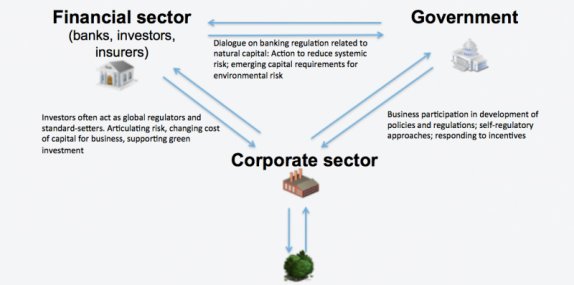
Article originally posted on the WAVES (Wealth Accounting and the Valuation of Ecosystem Services) website.
Earlier this year on the first day of the Advancing Natural Capital in Government, Business, & Finance event, representatives from the three corners of the natural capital accounting (NCA) triangle- government, business and finance- discussed the role of natural capital during a panel debate on developments in the three sectors, and the landscape of existing collaboration and links between initiatives. Participants agreed that the 'public' or consumer, is an important element in the equation.
Government:
At the national level, various methodologies and approaches have aligned under the United Nations System of Environmental-Economic Accounting (SEEA), which includes internationally agreed standard concepts, definitions, classifications, accounting rules and tables for producing internationally comparable statistics on the environment and its relationship with the economy. The SEEA has provided a launching pad for initiatives such as the World Bank-led WAVES partnership, which works to implement natural capital accounting in eight core implementing countries, as well as engaging with 70 partner countries.
"Statisticians play an important role in the process of harmonizing standards. We have done an outstanding job of harmonizing the way in which we measure the economy (SNA-System of National Accounts) and our relationship with the environment (SEEA). Now is the time to harmonize the way in which we think about sustainable development,” said Rutger Hoekstra, a senior researcher at Statistics Netherlands and former chair of the UN-ECE/OECD/Eurostat Task Force on Measuring Sustainable Development.
Constructing accounts can be instrumental in countries with a high dependency on natural resources to determine if they are being used sustainably, and how they feed back into the economy. Water accounts can be especially important in countries facing a scarcity.
“The paradox in Brazil is we have a lot of water in the Amazon region, but not in Rio and São Paulo. Another paradox is that our droughts have always been in the poorest regions in the country and not in the richest, and the lack of water is also effecting the amount of clean energy we generate from hydroelectric plants," said Paulo Gonzaga Mibielli de Carvalho, an economist with the Brazilian Institute of Geography and Statistics.
He says they are facing a lack of information about water, especially in the business sector where a majority of companies do not measure their water use. Mibielli de Carvalho said this is not just a problem for developing countries. California's drought is uncovering that water has not been measured or managed sustainably.
Corporate Sector:
The business sector has been pushing ahead on how to assess and embed natural capital-related risks in their operations. The
Natural Capital Coalition—formerly TEEB for Business—is a multi-stakeholder initiative making the case that business needs to account for its natural capital dependencies and impacts in the same way it does for financial capital.
Jerome Perez, Head of Sustainability for Nestlé-Nespresso S.A., spoke about natural capital as the key dimension to help address today’s challenges of resource scarcity, biodiversity and climate change. “As an organization that is dependent on nature, it is a critical element that we need to address. At a coffee farm it is easy to see natural capital at work and that to sustain our business we need productive soil, shade trees, water, and biodiversity for pollination.”
“NCA deserves the same norm as financial accounting: relevant, consistent, understandable, and that can be verified,” said Perez.
Libby Bernick, Senior Vice President of North America for Trucost, a London-based research firm that measures and values natural capital, said “There is a lot of data out there, but organizations need to put the data into both business context and environmental context in order to answer questions like, ‘How much natural capital is needed to grow revenue, and is it available in the areas where we want to grow our business?’” Bernick supported efforts to harmonize metrics, language and terminology.
Financial sector (banks, investors, insurers):
For the financial sector, the natural capital priorities are: credit and investment risk management, and developing tailored financial products, e.g. green bonds.
“If our customers are not managing natural capital appropriately, it translates into risk for us. Water as a natural capital risk plays out significantly (in Australia). Customers can increase the potential for default if they are not thinking about the management of water resources when drought occurs,” said Rosemary Bissett, Head of Sustainability, Governance and Risk at National Australia Bank (NAB), Australia’s biggest rural lender and one of the first signatories of the NCD.
The
Natural Capital Declaration, launched at Rio+20 in 2012, leads this initiative, which commits banks, investors and insurers to integrate natural capital considerations into their operations, and in particular the cost of capital.
The World Forum on Natural Capital which will take place in Edinburgh on 23-24 November and a crucial international platform for sharing information and expertise to feed into the cross-sector momentum on natural capital. Click here to reserve your place.
